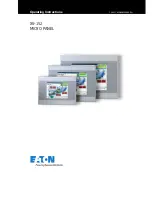
60
OPErATING SySTEMS
4 Operating systems
4.1 EWf implementation in the Windows Embedded Standard 7 images
All the KEB Windows Embedded Standard 7 images have a built-in support for Enhan-
ced Write Filter (EWF).
EWF protects a volume from write access.
Its two major components are the EWF Overlay and the EWF Volume:
• EWF Overlay: EWF protects the contents of a volume by redirecting all write opera-
tions to another storage location. This location is called an overlay. An EWF overlay
can be in RAM, or on another disk partition. An overlay is conceptually similar to
a transparency overlay on an overhead projector. Any change that is made to the
overlay affects the picture as it is seen in the aggregate, but if the overlay is remo-
ved, the underlying picture remains unchanged.
• EWF Volume: In addition to the EWF overlay, an EWF volume is created on the me-
dia in unpartitioned disk space. This EWF volume stores configuration information
about all of the EWF-protected volumes on the device, including the number and
sizes of protected volumes and overlay levels. Only one EWF volume is created on
your device, regardless of how many disks are in the system. If your media does not
support multiple partitions, you can save the EWF configuration infor-mation in the
system‘s registry (RAM Reg Mode, KEB’s choice)
EWF has been configured by KEB for protecting the C: volume, using RAM Reg Mode.
So, the overlay is in RAM and the EWF volume location is in system registry.
When EWF will be enabled, every write operation for C: will be redirected to an Overlay
in RAM.
No data will be persistently stored into the C: volume.
In case of a reboot or of a system restart after a power failure, the overlay will be reset
and all the data written in the previous session will be lost. The view of the C: volume will
be the same, after every reboot.
Having a non-persistent C: will force the customer to manage at least another volume (a
separate D: partition, another storage device, a network share) that contains persistent
data for the application.
This second volume will not be protected from power failures, but will not contain infor-
mation that is vital for system booting.
On KEB Windows Embedded Standard 7 images, EWF is disabled by default at ship-
ment and it must be enabled by the customer, in case it is needed.
Summary of Contents for C6 E22 BM-RVL
Page 1: ...EMBEDDED IPCS INSTRUCTIONS FOR USE E22 BOX PANEL Original Manual Document 20146638 EN 01 ...
Page 2: ......
Page 11: ...11 List of Figures Figure 89 External connectors 108 Figure 90 Buttons position detail 108 ...
Page 48: ...48 Installationand connection ...
Page 96: ...96 Drawings 7 1 4 C6 E22 PANEL SL S1 12 1 W Figure 75 12 1 Wide dimensions ...
Page 110: ...110 Certificatesandapprovals 8 Certificates and approvals 8 1 EU Declaration of conformity ...
Page 111: ...111 Certificatesandapprovals ...
Page 114: ......
















































